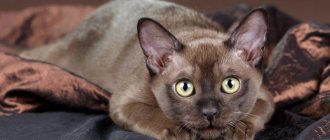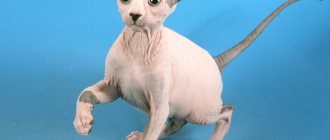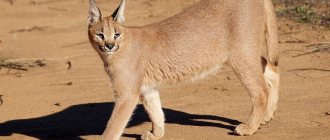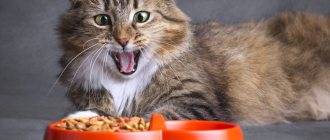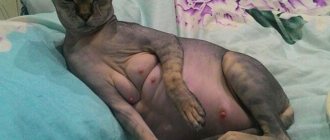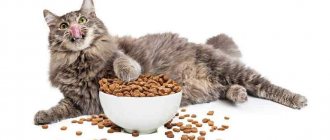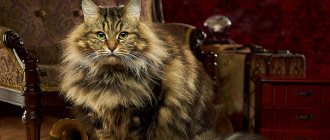Cats that look more like alien creatures are distinguished by their unusual appearance. This is an ideal choice for those who want to have a special pet. Their gentle and calm nature makes them perfect for families with children. How much a Sphynx costs depends on the class, color, documents and pedigree.
- Price range for a kitten: from 5 to 100 thousand rubles .
Cost of sphinxes
Breed standards and characteristics
| Head | It has a wedge shape with prominent cheekbones and a straight nose. There are small folds of skin on the top of the head. The nose is straight. The neck is of medium length, muscular. Despite the fact that their ancestors had mustaches, the sphinxes did not inherit them. |
| Ears | Big as bat wings. Vertically standing huge prickly pointed or rounded ones. |
| Eyes | Important characteristics are the lemon-shaped eyes, narrow at the edges. Eye color may vary. Canadians may have heterochromia in one or both eyes. |
| Body | Medium size, muscular, hot to the touch, with a wide chest, sometimes barrel-shaped. |
| Weight | The weight of an adult cat is 3.5–5 kg. Even the largest individuals do not weigh more than 5–6 kg. |
| Limbs | The legs are slender, strong, muscular, of medium length, proportional to the body. The hind limbs are slightly longer than the forelimbs. The joints are pronounced. |
| Tail | Flexible and long, tapering at the end. |
| Wool | The length of the wool does not exceed 1–2 mm. The skin is smooth to the touch, thick and wrinkled. |
Interesting! Sphynx cats cannot be described without mentioning the incredible number of folds of skin they have. The more folds, the higher the value. They have so much bare skin that even if the animal were stretched to its full length, it would still have folds.
What else you should know about the Sphinx:
- An adult sphinx is covered with fine down, reminiscent of a peach to the touch.
- The Sphynx's ears are 2-3 inches (5-7 cm) high.
- The friendly Sphynx is easy to communicate with and loves to make new acquaintances. It can become not only an excellent exhibition specimen, but also a friend and family companion.
- The Sphynx is a strong breed, with medium bones and a muscular and athletic build.
- Since the breed has no fur or hair, water treatments should be carried out frequently.
Appearance of the Sphinx
Sphynx kittens
Sphynxes are not large breeds. Females usually weigh 3.5-4 kg, males weigh between 5-7 kg. At the same time, the body is muscular and dense, which is why cats actually turn out to be heavier than one might expect given their size. The skin is thick and gathers into characteristic folds, especially pronounced on the muzzle.
Head
Medium in size, shaped like a slightly rounded modified wedge, where the length is slightly greater than the width. The forehead is flat, the transition from it to the muzzle can be either quite soft or clearly pronounced. The muzzle is short. The cheekbones are high and clearly defined. The chin is strong and forms a perpendicular to the upper lip. The nose is short, with a slight to medium stop. The whisker pads are well developed, although the whiskers themselves are completely or almost completely absent.
Ears
Ears are one of the distinctive features of the Canadian Sphynx breed. Very large compared to the head. Upright and open. The base is wide. The inner surface is without wool.
Eyes
The eyes of sphinxes are large, shaped like a lemon, because with a wide middle part they narrow equally on both sides. Set wide and slightly slanted. The color is not regulated, but must be in harmony with the color.
Neck
Medium length, slightly arched, with well-developed muscles.
Face of the Canadian Sphynx
Body
Sphynx paws
The body of the sphinx is of medium length, muscular. The chest is wide and rounded. The belly is round and full. The back of the body is rounded.
Legs
Medium length, proportional to the body. Strong and muscular. The hind ones are slightly longer than the front ones.
Paws
Oval, with thick pads and well-developed long toes.
Tail
White Sphynx
The length of the Sphynx's tail is proportional to its body. Graceful and flexible, gradually tapering from base to tip.
Cover and skin
The skin of the Canadian Sphynx is thick and forms folds, which are especially numerous on the face and legs. They seem completely hairless, but usually the body is covered with delicate down (a length of no more than 2 mm is allowed). The norm is the presence of short, sparse hair on the outside of the ears, tail, between the toes and in the scrotum area. The bridge of the nose is covered with the usual short hair for cats.
Color
Despite the lack of hair in the usual sense, sphinxes have many colors: white, black, red, chocolate, lilac (lavender), tabby, tortoiseshell, two-color, calico (tri-color), color point, mink. Neither conflicts with the CFA standard.
Solid color
The different shades of sphinxes are actually the skin's own pigmentation and a thin layer of mossy down. When exposed to sunlight, a cat may tan and its color will become brighter.
Let's look at the main types of Sphynx colors:
| Black | The tone of the Canadian Sphynx is black and one-level. The skin of the nose is black, the skin of the paw pads is black or brown. |
| Blue | Shimmers from blue to blue. The nose and paw pads are dark blue. |
| Red (Red) | Deep shade, rich, brilliant red-red color. The lips, chin, nose and paw pads are red brick. |
| White | The color shimmers from white to pink. The nose of the white Canadian Sphynx has a pink tint, and the pads of its paws are the same color. |
| Cream | Single level cream shade. The skin of the nose and paw pads is also pink. |
| Chocolate | Chestnut-chocolate, rich color. The nose and paw pads are brownish. |
| Lilac | The shade is grayish with a mauve tint. The nose and paw pads of the Sphinx are pinkish-lilac. |
Tabby color (tabby) and its shades
| Classic spotted | There are clearly defined spots on the sphinx's paws and tail. The pattern is scattered over the entire body, with the exception of the tummy. |
| Mackerel/Tiger | A spotted pattern resembling stripes clearly marked on the tail and legs. Stripes are present throughout the body and on the head. |
| Marble | The spots can have a round, oblong shape, repeating the pattern of marble. |
| Silver | Pale transparent silver color. The spots and stripes are densely black. |
| Brown | Copper-brown shade, shiny. The markings are solid black. The hindquarters of the Sphynx's legs are black. |
| Blue | It has a pale bluish tint, closer to ivory. Dark blue markings provide good contrast. |
| Cream | The skin is pale cream. The marking shade is darker than the base color, which provides contrast. |
Tortoiseshells (totrie)
The spotted tortoiseshell color of Totrie with red-red and cream markings is more characteristic of female Sphynx cats. They are very rare in males and are considered a deviation.
The variation and proportions of pigmentation are different:
- "Black Carapace": Black and tawny spots cover the Sphynx's skin throughout the body.
- “Blue and Cream”: Blue-blue spots mixed with cream color.
- “Chocolate Shell”: A rich, bright chestnut brown shade with flecks of red.
- “Cinnamon”: Reddish-reddish flecks mixed with cinnamon-colored spots.
- "Mauve Turtle": Cream flecks are placed on a light lavender, lilac shade.
- “Natural Faun”: The cream color of the sphinx’s skin is decorated with cream spots.
Choosing a good pet: what to look for
For some this will sound banal and primitive, but you need to choose with your heart. Thanks to your feelings, you will certainly be able to find your pet. It is advisable to look at kittens from different breeders to make the right decision.
What features should you pay attention to when choosing a hairless kitten:
- mobility and playfulness;
- feeling well (sneezing indicates a cold);
- vaccination (at approximately 3.5 months);
- a stable state suggests a temperature of 39-40 ° (sometimes reaching 42 °);
- there is no dandruff, no peeling of the skin (otherwise there is a fungal disease);
- good color (in babies it is quite difficult to determine), which is revealed by skin pigment and the shade of rare hairs appearing on the skin; The most common colors are chocolate, blue, tortoiseshell and white.
Calico CALICO
- White CALICO: white with spots of black and tan. White color predominates on the lower parts of the body.
- Van CALICO: white shade mixed with red and black spots, present on the limbs, head, tail. One or two small spots of color on the body are allowed.
- Dilute CALICO: white color with grayish-blue, cream spots. Predominant on the lower parts of the sphinx's body.
- Dilute Van CALICO: white with blue, cream, red spots located on the legs, tail and head. One or two small spots of color on the body are allowed.
Origin story
Mentions of hairless cats can be found in the chronicles of different nations. This is due to the fact that a hairless kitten could appear from completely ordinary parents. Initially, such unusual kittens were considered discarded.
Reference! The appearance of the Sphinx is considered a natural mutation.
Officially, the birth of the breed is considered to be 1966. Then in Toronto (Canada) a domestic cat gave birth to a hairless kitten. The cat's owner gave the baby the name Prune (Prune). At the same time, sphinxes began to appear in nurseries.
Initially, the kittens were called “Canadian Hairless Cat,” but not everyone liked such a long and ordinary name. Fans of hairless cats were looking for a euphonious name for the breed and drew parallels with the oldest surviving sculpture - the Egyptian Great Sphinx.
What factors influence the price
First of all, a hairless cat has certain standards. Consequently, after the kittens are born, they receive a specific class.
- Show. This class is assigned to kittens that meet a whole list of standards. The price is affected by gender, amount of wool, parents.
- Breed. It is appropriate to include in this category those kittens that will be used for breeding in the future.
- Pat. This class is given to kittens born that do not meet any point of the standard. A cat of this class is perfect as a pet. This includes pets that do not have a pedigree.
Description of the breed
A distinctive feature of the breed is hairlessness, but it is not the only one.
Sphynx standard
A purebred Sphynx must meet the following standards:
- Body: warm and soft to the touch, like a soft peach. Average build with unexpectedly high weight; the belly is rounded. Sphinxes are characterized by sexual dimorphism, i.e. The difference between females and males is in size and weight - females are much smaller than males. Thus, the weight of a male reaches 5 kg, of a female – up to 3.5 kg.
- Limbs: proportional, muscular. The hind legs are longer than the front legs. The front legs are set wide due to the large chest (“bulldog” style). The pads of the toes are thick and make the paw look like a baby's fist.
- Head: the shape resembles a modified wedge, the length of the head is slightly greater than the width, pronounced cheekbones. The skull is rounded, the nose is straight with a pronounced “hollow” where the forehead meets the nose.
- Eyes: large, round, lemon-shaped (wide in the middle and tapering towards the edges); the distance between the eyes is slightly larger than the size of the eye. Any eye color.
- Ears: very large, open, erect. Set wide apart, without brushes.
- Wool: a small light fluff on the skin is possible - the skin of a sphinx is often compared to the skin of a child; a tuft of hair at the tip of the tail is also acceptable. The length of hair on the body is divided into the following types:
- naked (homozygous) - hair and whiskers are completely absent, the body is covered with numerous folds of skin. Rarely born. Cats feel rubbery and sticky to the touch. It is difficult to stroke such a sphinx, so it is as if they are gently pinching the skin.
- flock - thin microhairs up to 0.1 cm; as sphinxes grow older, they can undress and become naked. The flock feels like velvet to the touch; such a cat can be stroked with your hand without difficulty.
- velor - wool 0.2 - 0.4 cm long. Wool may not be present on all parts of the body.
- brush (velor) - hair length up to 0.5 cm. The coat is straight or curled, like a Rex, and feels hard to the touch.
Colors
The color of sphinxes without hair is determined by pigmentation on the skin. The color of the naked-born Sphynx appears 2-3 hours after birth.
Types of colors of Canadian Sphynxes:
- Solid: the predominance of one color in pigmentation. The nose is combined with the color, the paw pads are either the color of the pigmentation or a pinkish tint. Possible colors:
- white;
- cream;
- lilac;
- blue;
- faun;
- cinnamon;
- red (red);
- chocolate;
- black.
- Tortoiseshell (totrie): Characteristic only for females. It is rarely found in cats and is regarded as a deviation - such males are most often infertile. Pigmentation consists of two colors: in the classic version – black and red; in clarified - blue and cream. Proportions and variations may vary. Possible options:
- blue turtle;
- black;
- lilac;
- chocolate cake;
- tortoiseshell cinnamon;
- tortoiseshell faun.
- Tabby color (tabby): dark spots on the back, tail and limbs. The nose and paw pads are either pigmented or pinkish in color (typical of light colors). Tabby color types:
- spotted – pigmentation in the form of spots;
- marbled - spots on the body in the form of patterns similar to stripes on marble;
- tiger/mackerel – spots in the form of horizontal stripes.
- Bicolor: primary color (solid, tortoiseshell, tabby) combined with white. The painted part has clear boundaries from white. One ear should be painted. The nose and paw pads match the base color.
- Color-point: The color characteristic of Siamese cats is a light body with darker tips of the ears, nose, paws and tail. Characteristic eye color is sky blue. The paw pads and nose match the color of the point. Depending on the “darkened” color, color options can be:
- seal point;
- chocolate point;
- blue point;
- lilac point;
- cream point.
How much does a Sphynx cat cost, price in Moscow
Prices for Sphynx kittens in Moscow
The price range for Sphynx cats in Moscow varies depending on the nursery. Each breeder determines the cost based on the color of the animal, its pedigree, maintenance costs, and class. You can take a kitten as a pet without the intention of participating in exhibitions or breeding from 5 thousand rubles . The price for a show class cat with a good pedigree and a rare color can reach 80 thousand rubles . The prestige of the nursery also affects the cost of the Sphynx.
In Moscow there are a large number of nurseries where you can choose a kitten of any class and color. Here you can choose a healthy pet whose origin you won’t have to doubt. Breeders with an impeccable reputation will always provide documents confirming pedigree, a veterinarian’s report, and a passport with the necessary vaccinations according to age.
In the table you can see the price of Sphynx kittens in Moscow:
| Class | Cost of a cat in rubles | Cost of a cat in rubles |
| Pat | 5 000-18 000 | 6 500-30 000 |
| Breed | 17 000-20 000 | 30 000-50 000 |
| Show | 20 000-50 000 | 50 000-80 000 |
Table 1. Prices for Sphynx kittens in Moscow
Differences between the Canadian, Don and St. Petersburg sphinxes
The Canadian Sphynx became the first breed to officially recognize hairlessness as a standard. The Don Sphynx and Peterbald are related breeds whose homeland is Russia. The St. Petersburg Sphynx appeared as a result of crossing the Donchak and the Oriental cat.
Visual differences in the structure of the muzzle of these three breeds are clearly visible in the photo below.
| Petersburg Sphinx | Canadian Sphynx | Don Sphynx |
| Elongated, elegant body with well-developed muscles and a long neck. Long straight tail, slightly tapering to the tip. | Average build with a round belly. Wide chest. Large paw pads Thin whip-shaped tail | Strong medium to large bone, prominent belly Straight, medium length tail |
| The shape of the head is an equilateral triangle, an elongated profile with a clear line connecting the tip of the nose and the chin. Flat forehead, long nose | The head shape is wedge. There is a hollow on the bridge of the nose. Well defined cheekbones, short profile | Wedge-shaped head with a firm chin. Straight nose, elongated profile, but shorter than Peterbalds |
| Almond shaped eyes | Lemon eye shape | Almond shaped eyes |
| Triangular ears with a wide base, set apart | Large erect ears, rounded at the ends. Wide head stance | Large ears with a slight forward tilt |
| Elastic skin with small folds on the neck, abdomen, folds of the paws and head | Thick skin with numerous large folds throughout the body | Most folds are located on the head, abdomen, groin and armpits |
How much does the Don Sphynx cost?
Nurseries offer wonderful kittens that meet the standards of this breed. The cost of the Don Sphynx ranges from 9-30 thousand rubles.
Buying a hairless kitten today is easy. In Russia there are a huge number of nurseries that qualify for breeding this breed. In turn, many are ready to deliver the animal to neighboring regions, and sometimes anywhere in Russia. Meanwhile, such a number of nurseries obliges the potential buyer to carefully approach the choice of purchase location. First, you should read the reviews of the selected nursery.
In addition to registered establishments, there is the option of purchasing a Sphinx from a private individual. In this case, the breeder can provide a pedigree. The veterinary passport usually indicates the necessary vaccinations appropriate for age, but you should not count on a detailed examination of the pet’s health.
Health
Despite their fragile appearance, cats have high immunity and are little susceptible to infectious diseases. Canadian Sphynxes live quite a long time - the average life expectancy is 12-16 years . However, there have been recorded cases of bald centenarians celebrating their 20th anniversary.
Due to the lack of a warm coat, like Somali cats, for example, Sphynx cats are susceptible to air temperature. They are more likely to have skin diseases (acne, dermatitis, acne, fungal and yeast infections).
Important! The Sphynx quickly catches colds and respiratory diseases, so make sure that there are no drafts in the apartment.
To protect your pet from illness, buy, sew or knit warm clothes for him for the winter - many pets like this.
There are also a number of diseases characteristic of the Canadian breed:
- Urticaria pigmentosa . A rash on the body can be caused by an allergic reaction, including food. The exact cause can only be determined by analysis.
- Hypertrophic cardiomyopathy . This heart disease is associated with a genetic mutation.
- Myopathy . The most dangerous disease in a kitten. It appears at an early age and is characterized by progressive muscle dysfunction. There is no cure, it develops individually and often leads to death. In the nursery, the potential owner is immediately warned if the kitten is at risk.
Bathing a Sphynx kitten
Unlike their furry counterparts, Sphynx cats need frequent bathing. The fact is that their skin has many sweat and sebaceous glands, but does not have wool, for the lubrication of which all this wealth is intended. Therefore, the Sphynx kitten sweats quickly and an unpleasant odor appears. If you delay bathing, greasy crusts may appear on the skin. The skin underneath it itches, becomes inflamed, and the animal begins to scratch it...
Sphynxes are bathed 2-4 times a month. For bathing, use special mild shampoos, preferably specially designed for this breed; in extreme cases, cat shampoos for sensitive skin.
Otherwise, bathing sphinxes proceeds in the same way as other cats. Particular care should be taken when washing your hair to prevent water from getting into your ears. Sometimes it is even recommended to plug them with a cotton swab.
Sphynx ears also require more careful care than other cats. Due to the lack of wool, dust gets into them more easily. After each bath, wipe the inside of the ears with a cotton pad. Moistened with Vaseline oil, carefully and thoroughly treating each fold.
The character of the Canadian Sphynx
Unlike most other breeds, sphinxes are deprived of the hunting instinct - instead of it, these cute creatures received extreme love and affection. They are devoted to their owner - they love to sit in their arms and sleep next to them. Cats love attention and painfully endure loneliness and separation from their owner - they become withdrawn and even aggressive.
Advice! Sphynxes get along well with cats of other breeds, dogs and rodents. Therefore, if you are looking for a second pet for the family, we advise you to pay attention to this breed.
Sphynxes are very smart pets and are easy to train . Their activity and playfulness does not disappear until old age, and if there is nothing to occupy the animal, it finds something to do on its own and plays pranks.
a high level of friendliness both towards other animals and towards small children. They make contact and are full of energy for games, and high patience allows animals not to show aggression. The main thing is that the games be careful, because the Sphynx does not have fur protection from scratches and bruises.
Interesting fact! Compact by nature, Sphynxes love to climb onto their owners’ shoulders and move around the apartment in this way.
Sphinx food
In this aspect, the Sphynx kitten will definitely please its owner. This cat is an omnivore and is rarely spoiled. She will happily eat the food offered by the owner. The reason for this behavior lies in the increased metabolism due to the lack of fur and high temperature.
In turn, when a kitten greedily grabs pieces of food, you don’t need to think that it needs additional feeding. This is just a characteristic feature of the breed.
There is no need to put your pet on dry or canned food. Here, the combination that provides the necessary vitamins plays a significant role. The main thing is that any food must be of high quality.
Who is not recommended to start
Canadian Sphynxes are quite unpretentious animals and can find the key to the heart of any person, however, there are features that you need to pay attention to before buying a hairless baby.
- Allergy . If you suffer from an allergy to cats, then even a hairless pet will not save you from it. In most cases, the allergen is cat protein, which is found in saliva, sweat and feline waste. And Sphynxes sweat all over their bodies, unlike other breeds!
- Lack of time for care . The need to bathe your pet weekly will raise serious doubts for some people. If you want a cat that doesn't require any maintenance, then the Sphynx is not for you.
- Frequent absence from home . Sphynxes are attached to their owners, so a prolonged absence of human communication is always stressful for the pet. You should not choose a Sphynx as a pet if you lead an active lifestyle outside the home.
Of course, caring for a pet will be different from caring for a cat with a wool coat. However, it is not as difficult as it might seem at first glance - the main thing is to follow the basic rules.
Wool
Increased body temperature also affects the animal's sweating - sphinxes sweat a lot. Sweat has a rather specific smell, so caring for your pet's skin should be regular - bathe it once a week and wipe it with a damp cloth as needed. If you neglect skin care, a gray coating forms on it - a mixture of dirt, sweat and sebum.
Reference! It is better to take wipes and shampoo that are hypoallergenic and fragrance-free. You can choose children's ones so as not to provoke irritation on your pet's delicate skin.
You should bathe only in warm water, after which you must wrap it in a terry towel, otherwise the baby may freeze and catch a cold.
Nutrition
Due to their elevated body temperature, Sphynx cats have an accelerated metabolism. Therefore, they need to eat more than representatives of other breeds. The Sphynx should be fed no more than twice a day, preferably at the same time.
Important! Obesity is a common disease among Sphynx cats. You should not feed your pet every time he asks.
There are two main nutritional concepts, from which each owner chooses the most suitable:
- Natural food (meat, sea fish, dairy products). In this case, you need to add vitamins to your diet. Also try to minimize the amount of fatty foods, as they are harmful to your pet. Meat should be given only in the form of pieces, and not minced meat, which will ensure the cat has healthy teeth.
- Ready food . If you prefer ready-made food, pay attention to its quality. To ensure a balanced diet, you should purchase super-premium food and higher.
Important! Remember, extensive advertising of a product is not at all a sign of quality - first of all, pay attention to the composition of the food.
When choosing any food concept, do not forget that your pet should always have a bowl of clean and fresh water.
Caring for ears, eyes, claws
Sphynx cats, like other cats, can accumulate dirt between their claws and in their ears, which cats of other breeds cover with a fluffy coat.
- Ears . The secretion accumulated in a pet's ears does not pose a danger and does not interfere with hearing, but outwardly it does not look aesthetically pleasing. You should clean your pet’s ears like a small child – with a cotton swab (not a swab), carefully and slowly.
- Claws . In addition to regularly cleaning the dirt between the claws, it is worth paying attention to the claws themselves - trimming them will help the owner keep the furniture in its original form.
- Eyes . It is also necessary to monitor the condition of the eyes to avoid various infections. You can wipe your pet's eyes with green tea or chamomile decoction using a cotton swab.
Walking your pet
Some experts agree that the Sphynx is exclusively a domestic animal. However, to provide your cat with physical activity, it is possible and even beneficial to take him for a walk, but no more than 1-2 times a week.
Important! You can only take your pet for a walk in warm, dry weather.
Sphynxes love to soak up the sun. Tanning (yes, hairless cats can tan too!) causes their thin skin to slightly change pigment - bronze shades appear, as well as freckles and spots.
Important! Do not leave your pet under the scorching rays of the sun - severe burns may occur on its delicate skin.
In general, it is enough for a cat to install a high scratching post and buy several toys. Sphinxes especially love pointers with feathers tied to them and running mice running on batteries.
Useful video:
What determines the price of the Canadian Sphynx
The cost of an unusual kitten is affected by its class, color, titles of parents, and availability of documents. Also, the price may be higher for cats that have great breeding prospects.
Division of the Canadian Sphynx by class:
- Pat . Ideal as pets. They have all the typical characteristics of the breed, but have some deviations. They are not suitable for breeding or exhibition. Usually such kittens are sold already sterilized.
- Brid . Cats intended for breeding. They meet all breed standards. This is a healthy cat with good reproductive traits.
- Show . The standard of the breed, the highest price. Ideal for breeding and exhibitions.
The price of a Sphynx cat is also influenced by the medals of the parents. A high title means not only the status of a pedigree, but also speaks of large expenses at exhibitions and preparation for them. A kitten of a rare color will cost more.
In addition, the cost of the Sphynx includes the following costs for the nursery or breeder:
- nutrition;
- mating;
- toilet and procedures;
- vet;
- paperwork;
- advertising.
Girls are more expensive due to the fact that they repeatedly bear offspring, which fully covers the cost of purchasing them.
Breed card
| Characteristics of a cat | Notes | |
| General information | The Canadian Sphynx is the original breed that created the fashion for “hairless” cats | The birthplace of the breed is Canada |
| Character | Playful and affectionate cat, very attached to family members | The Sphynx's playfulness does not disappear with age |
| Appearance | Medium-sized cats, wedge-shaped head, numerous folds on the skin. A large number of colors. Several types of wool: naked, velor, flock, brushed | Cats feel hot and velvety to the touch |
| Behavior at home | They love to curl up in a ball and sleep under a blanket, and also climb onto their owner’s shoulders. | Sunbathing lovers |
| Care | Weekly bathing and wiping with wet wipes to remove excess sebum and sweat | |
| Health problems | Various skin diseases and hypertrophic cardiomyopathy occur | Cats are afraid of cold and extreme heat |
How to choose a kitten
It is recommended to purchase a kitten only from trusted nurseries, since they may offer you not an exotic baby, but a sick animal. This is due to the difficulties of breeding the breed and the dishonesty of sellers.
You should not buy a kitten that is too young, as its body is still weak and can get an infection when moving, even under stress.
Reference! The optimal age for a baby to buy starts from 3 months. By this time, the baby is already strong and has the necessary vaccinations.
If your future pet is a personal companion and not a show winner, then it is enough to make sure that he is healthy. The kitten should be active, cheerful, and not show aggression or fear at the sight of a person. Sometimes kittens have a small rash on their tail - there is nothing wrong with that, it will go away on its own over time.
The final color of the kitten, as well as the color of the eyes, become clear to an experienced breeder already in the first weeks of the baby’s life.
It’s worth noting right away that sphinxes are not a cheap pleasure. If you are offered to buy a kitten for 3-4 thousand rubles, in this case there can be no talk of any pedigree.
The price of kittens in trusted nurseries starts from 10 thousand rubles.
Kittens that have deviations from breed standards are a little cheaper. They are not critical if you take a handsome bald man for your soul.
But promising kids - potential exhibitors and future producers, whose parents have championship titles, will cost at least 15 thousand rubles .
How much does a Canadian Sphynx from a foreign nursery cost?
The cost of a Sphynx abroad
In France and Belgium there are single-breed nurseries where you can buy a kitten of a rare color with a decent pedigree. There is a queue for such kittens even before their parents are mated. In the USA you can also find purebred kittens with excellent pedigree. Most often, Russian breeders order kittens from foreign nurseries in order not to use inbreeding (close relationships) in their breeding program. This is important for maintaining the genetic health of cats.
The cost of a Sphynx kitten in foreign nurseries:
| A country | Price |
| USA | 900-2800$ |
| Canada | 1000-3000$ |
| Countries of Europe | from 800€ |
Table 4. Prices for Sphynx kittens abroad
Sphynxes are amazing creatures that are distinguished by their unusual appearance.
It's impossible not to fall in love with them. But you should choose them carefully, checking the documents, so as not to get a sick animal, which will bring more trouble than joy. You should only buy a Sphynx from a certified nursery. Video: All about sphinxes
Interesting Facts
- Sphynxes completely destroy the well-known myth that cats hate water. Hairless cats are avid water swimmers . The main thing is that the water is warm.
- They are excellent jumpers . Young sphinxes easily conquer a height of 1 meter, and for adults, even a 3-meter height will not be an obstacle. Therefore, it is unlikely that you will be able to hide something from the sphinx on the closet.
- In ancient times, hairless cats were considered a sacred animal.
- Sphynxes are true models of the cat world. They love to pose so much that every guest in the house, in their opinion, comes to look at the spectacular handsome man. American photographers have repeatedly noted that the Canadian Sphynx is one of the most photogenic breeds.
- This is the most human-dependent breed. In natural conditions, sphinxes will not be able to survive, since they do not have natural “radars” of danger - vibrissae.
The Sphinx can become a full-fledged member of the family. Although he needs special care, his affection and devotion make up for this many times over. Plus, there will never be wool in the house or on clothes. Do you like Canadian Sphynxes? Leave your feedback in the comments, let's see how many of our readers are bald lovers.
Source

